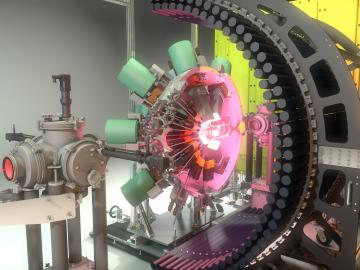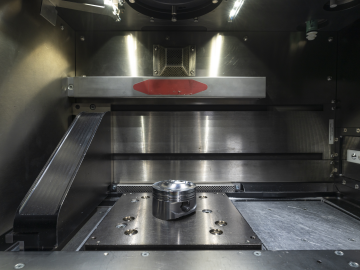
Filter News
Area of Research
- (-) Materials (112)
- (-) National Security (24)
- (-) Nuclear Science and Technology (39)
- Advanced Manufacturing (2)
- Biology and Environment (62)
- Biology and Soft Matter (1)
- Computational Engineering (2)
- Computer Science (6)
- Electricity and Smart Grid (3)
- Energy Frontier Research Centers (1)
- Energy Science (85)
- Fuel Cycle Science and Technology (1)
- Functional Materials for Energy (1)
- Fusion and Fission (31)
- Fusion Energy (12)
- Isotope Development and Production (1)
- Isotopes (4)
- Materials for Computing (10)
- Mathematics (1)
- Neutron Science (26)
- Nuclear Systems Modeling, Simulation and Validation (2)
- Quantum information Science (2)
- Sensors and Controls (1)
- Supercomputing (62)
News Topics
- (-) Advanced Reactors (15)
- (-) Big Data (7)
- (-) Chemical Sciences (32)
- (-) Grid (11)
- (-) Nanotechnology (39)
- (-) Nuclear Energy (53)
- (-) Partnerships (15)
- (-) Physics (30)
- 3-D Printing/Advanced Manufacturing (28)
- Artificial Intelligence (21)
- Bioenergy (15)
- Biology (8)
- Biomedical (9)
- Biotechnology (1)
- Buildings (6)
- Clean Water (3)
- Composites (9)
- Computer Science (35)
- Coronavirus (7)
- Critical Materials (13)
- Cybersecurity (21)
- Energy Storage (35)
- Environment (21)
- Exascale Computing (2)
- Frontier (3)
- Fusion (16)
- High-Performance Computing (8)
- Irradiation (1)
- Isotopes (16)
- ITER (1)
- Machine Learning (16)
- Materials (74)
- Materials Science (79)
- Mathematics (1)
- Microscopy (27)
- Molten Salt (7)
- National Security (35)
- Neutron Science (40)
- Polymers (17)
- Quantum Computing (3)
- Quantum Science (12)
- Security (11)
- Simulation (2)
- Space Exploration (7)
- Summit (4)
- Transportation (16)
Media Contacts

Little of the mixed consumer plastics thrown away or placed in recycle bins actually ends up being recycled. Nearly 90% is buried in landfills or incinerated at commercial facilities that generate greenhouse gases and airborne toxins. Neither outcome is ideal for the environment.

In a finding that helps elucidate how molten salts in advanced nuclear reactors might behave, scientists have shown how electrons interacting with the ions of the molten salt can form three states with different properties. Understanding these states can help predict the impact of radiation on the performance of salt-fueled reactors.

ORNL, a bastion of nuclear physics research for the past 80 years, is poised to strengthen its programs and service to the United States over the next decade if national recommendations of the Nuclear Science Advisory Committee, or NSAC, are enacted.

ORNL has been selected to lead an Energy Earthshot Research Center, or EERC, focused on developing chemical processes that use sustainable methods instead of burning fossil fuels to radically reduce industrial greenhouse gas emissions to stem climate change and limit the crisis of a rapidly warming planet.

Using light instead of heat, researchers at ORNL have found a new way to release carbon dioxide, or CO2, from a solvent used in direct air capture, or DAC, to trap this greenhouse gas. The novel approach paves the way for economically viable separation of CO2 from the atmosphere.

ORNL is leading two nuclear physics research projects within the Scientific Discovery through Advanced Computing, or SciDAC, program from the Department of Energy Office of Science.

Speakers, scientific workshops, speed networking, a student poster showcase and more energized the Annual User Meeting of the Department of Energy’s Center for Nanophase Materials Sciences, or CNMS, Aug. 7-10, near Market Square in downtown Knoxville, Tennessee.

Timothy Gray of ORNL led a study that may have revealed an unexpected change in the shape of an atomic nucleus. The surprise finding could affect our understanding of what holds nuclei together, how protons and neutrons interact and how elements form.

Dean Pierce of ORNL and a research team led by ORNL’s Alex Plotkowski were honored by DOE’s Vehicle Technologies Office for development of novel high-performance alloys that can withstand extreme environments.

JungHyun Bae is a nuclear scientist studying applications of particles that have some beneficial properties: They are everywhere, they are unlimited, they are safe.


